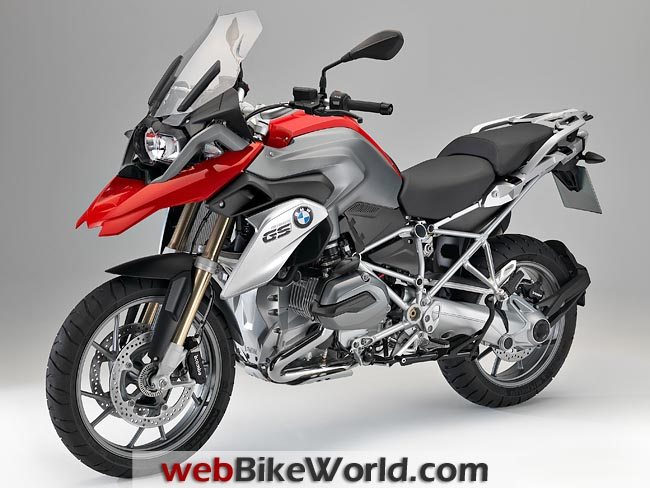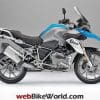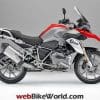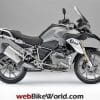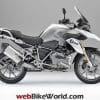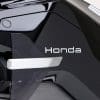The big news is that the R1200GS now has a water-cooled “Boxer” engine.
It is also the first motorcycle with an LED headlight.
But there’s a lot of added complexity, with “fly by wire” throttle, active suspension and more.
BMW provided a huge amount of information on the new GS and we’re publishing only a summary of it here.
A link to the complete .pdf file is included below. The following is adapted and edited from a rough German translation of the BMW press release:
New Water-Cooled Boxer Engine
The entire 2013 R1200GS was completely redefined, particularly the drive concept.
The performance aspired to, as well as adherence to future anticipated requirements in terms of noise and exhaust emissions, is ensured among other things by a change in the cooling system.
The boxer engine in the new R 1200 GS continues to use air/liquid cooling, however, the coolant oil has been replaced by a glycol-water mixture. This ensures a high level of heat absorption capacity of the cooling liquid for more efficient heat dissipation.
So-called precision cooling (a principle similar to that used in Formula 1) involves only those engine elements being cooled with coolant, which are particularly exposed to thermal stress.
The engine still continues to use air cooling, thereby preserving the characteristic appearance of the opposed twin boxer engine.
The two radiators are small and inconspicuously integrated.
The through-flow is now vertical instead of horizontal for improved filling, and the engine housing integrates the 6-speed gearbox as well as a wet clutch with anti-hopping function instead of the dry clutch as was used previously.
What is more, the secondary drive now runs via the well-established cardan shaft on the left-hand side.
With an output of 92 kW (125 bhp) at 7700 rpm and 125 Nm at 6500 RPM, the new engine offers superior power and performance in the travel enduro segment and beyond.
The empty weight (ready for the road) according to DIN of the R 1200 GS is 238 kg including standard BMW Motorrad Integral ABS.
E-Gas and Cruise Control
An electromotive throttle actuator is now used for the first time in a GS motorcycle. Here, rider commands are passed on directly by the sensor in the accelerator twist grip to the engine control system; this then regulates the throttle valve electronically.
The use of the E-gas system provides a significant improvement in terms of controllability and response.
What is more, the rider can adapt engine characteristics to the situation on the road by means of five modes (optional extra). It was also possible to include an electronic cruise control function (optional extra).
Automatic Stability Control
ASC and riding modes as an optional extra: five freely selectable modes: “Rain”, “Road”, “Dynamic”, “Enduro” and “Enduro Pro”.
For optimum adaptation to the rider’s individual needs and purpose, the new R 1200 GS now offers five freely selectable riding modes for the first time: these are an ex works option and feature three different E-gas settings and with varying engine characteristics.
Linked to this is Automatic Stability Control ASC with a special enduro configuration.
If this option is chosen, BMW Motorrad ABS, ASC and – if installed – the semi-active suspension are all adapted to the respective profiles of these five modes.
Semi-Active Suspension
BMW Motorrad Dynamic ESA for optimum riding dynamics in every situation as a factory option. The new semi-active suspension BMW Motorrad Dynamic ESA (Electronic Suspension Adjustment) taps into a whole new range of possibilities as well as providing maximum riding safety and performance.
Dynamic ESA monitors the vertical movement of front and rear wheel control as well as other parameters by means of a spring travel sensor in each position, and adapts the damping automatically to the situation depending on riding conditions and the maneuvers being carried out.
Damping adjustment at front and rear is effected by means of electrically controlled regulation valves.
New Chassis Design and Tire Sizes
New chassis with tubular steel bridge frame and specially adapted wheel/tire dimensions of 120/70 R19 at front and 170/60 R17 at rear as a world first.
The chassis of the R 1200 GS uses a completely newly developed tubular all-steel bridge frame with a bolt-on rear frame.
Along with the newly designed Telelever at the front and the EVO Paralever at the rear, this has resulted in a further significant increase in torsional stiffness and hence ride stability and steering precision.
Optimized handling qualities are the result of refined master geometric chassis data, and a longer swingarm provides further improved traction – especially when riding over rough terrain.
A globally unique feature of the new R 1200 GS are the tires in the sizes 120/70 R19 at the front and 170/60 R17 at the rear, specially adapted to improve performance.
Revised Brakes
The brake system of the R 1200 GS has been extensively revised, too. There are now radially mounted Brembo Monobloc brake calipers at the front and a larger brake disc at the rear.
In line with the BMW Motorrad principle “Safety 360°” the new GS is also fitted as standard with the BMW Motorrad ABS, here in the part integral version.
LED Headlight
The 2013 BMW R1200GS is the first motorcycle in the world with LED main headlight including integrated daytime running light for even greater safety when riding during the day and at night as an ex works option.
Even in its standard trim, the new R 1200 GS has a main headlight with optimized light efficiency. In order to be seen even better during the day, BMW Motorrad also offers a daytime running light as a factory option.
For excellent road illumination and therefore even greater safety both day and night, an LED main headlight with integrated daytime running light is fitted in a motorcycle for the first time ever.
It comprises innovative LED technology with a sophisticated cooling and de-condensation concept.
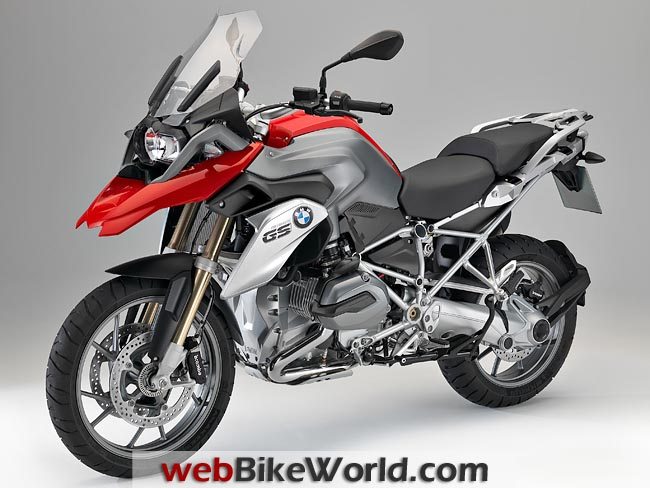
Features
The essential features of the 2013 BMW R 1200 GS at a glance:
- Completely newly designed engine for top-level riding dynamics within the travel enduro segment.
- Capacity 1170 cc, rated output 92 kW (125 bhp) at 7700 rpm and a maximum torque of 125 Nm at 6500 rpm.
- Cylinder heads with vertical through-flow for increased efficiency and performance.
- Compact air/water cooling for optimum heat management.
- Basic engine with compact, light and yet rigidity-optimized crankshaft.
- Vertically separated case in open deck construction.
- 6-speed gearbox integrated in engine housing, including wet clutch with anti-hopping function and reduced lever operation force.
- New intake system for optimum output and torque with 52 mm throttle valve diameter.
- E-gas for improved rideablity, running smoothness and special functions.
- Innovative exhaust gas system with electronically controlled exhaust flap for optimum performance characteristics and an earthy boxer sound.
- Freely selectable riding modes “Rain”, “Road”, “Dynamic”, “Enduro” and “Enduro Pro” with three different electromotive throttle actuator settings in conjunction with ASC (Automatic Stability Control), ABS and ASC settings for off-road riding as well as different mode-specific Dynamic ESA settings (option ex works).
- New suspension with torsionally stiff tubular steel bridge frame and bolt-on rear frame.
- Optimized lightweight cardan shaft drive now running on the left-hand side.
- Newly developed and optimized Telelever at front and EVO Paralever at rear for an even more precise ride feel.
- Refined master chassis geometry data and long swingarm for excellent traction.
- Optimized seating width and position, and adjustable handlebars for even greater comfort.
- Optimized ground reach for rider (inner leg length).
- Tire/wheel dimensions of 120/70 R19 at front and 170/60 R17 at rear as a world first, tailored specially to the R 1200 GS.
- Revised BMW Motorrad brake system with radially mounted Brembo Monobloc brake calipers at front and 2-piston floating caliper with enlarged brake disc at rear (Ø 276mm, previously 265mm).
- BMW Motorrad Integral ABS as standard.
- Semi-active suspension Dynamic ESA (ex works option).
- Main headlight with optimized light efficiency and LED daytime running light (ex works option).
- World’s first motorcycle with LED main headlight featuring integrated daytime running light (ex works option).
- New vehicle electrical system with partitioning of functions.
- Extended electric switch units.
- Electronic cruise control (ex works option).
- Preparation for navigation unit with Multi-Controller to operate the BMW Motorrad Navigator IV (ex works option).
- Windshield with one-hand operation for excellent wind and weather protection.
- Seat with multiple adjustment functions for perfect ergonomics.
- Number plate carriers quick to dismount for off-road riding.
- Increased ground clearance (+ 8 mm).
- New instrument cluster with on-board computer as standard. PRO on-board computer as an option.
- Four main paint finishes to choose from: Alpine White, Racing Red, Blue Fire and Thunder Grey Metallic.
- Extensive range of special accessories and rider equipment.
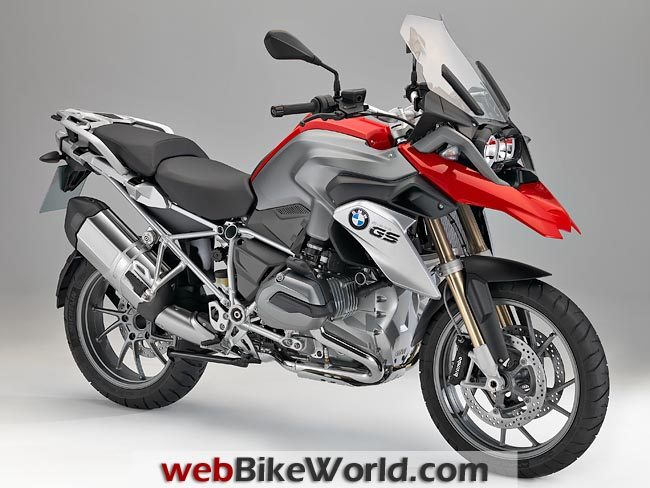
Drivetrain
Completely newly designed engine for maximum riding dynamics in the travel enduro segment. Like all engines in BMW motorcycles, the details of the boxer engine in the R 1200 GS are based on a carefully conceived overall concept.
Designed to perpetuate the almost 90-year tradition of the BMW boxer engine with a future-oriented concept created to hold good for years to come, the engine reproduces numerous classic engineering features but also offers a wealth of new technical solutions.
The strengths of the boxer have been further refined for the new BMW R 1200 GS so as to achieve a greater breadth of application in terms of touring suitability, dynamic performance and off-road qualities.
While the previous boxer power unit itself provided supreme forward thrust in all situations, the new BMW R 1200 GS takes a significant step further.
With its completely redesigned engine it offers a much higher level of dynamic performance, acceleration and pulling power across the entire engine speed range, both on the road and over rough terrain.
The totally newly developed 2-cylinder opposed-twin in the R 1200 GS has a capacity of 1170 cc as in the predecessor model.
The ratio of bore to stroke of 101 to 73 millimeters has also been preserved. The rated power output is 92 kW (125 bhp) at 7700 rpm, and its maximum torque of 125 Nm is available at 6,500 rpm.
Compact Air/Water Cooling
The boxer engine in the new R 1200 GS continues to use air/liquid cooling but the oil coolant has been replaced by a glycol water mixture for the first time in a BMW Motorrad boxer engine.
This ensures a high level of heat absorption capacity of the coolant for more efficient heat dissipation.
So-called precision cooling means that the cooling fluid flows through the thermally more heavily exposed engine elements – the two cylinder heads and parts of the cylinders. Heat dissipation is via two radiators positioned at the left and right of the front section.
These are inconspicuously integrated and well protected by the radiator covers.
An electric fan behind the right-hand radiator is automatically activated as needed, controlled by the thermostat.
For example at high outdoor temperatures in city traffic. Thanks to the sophisticated cool-air ducting on both sides, the warm air is streamlined past the rider.
The engine still also uses air cooling which reduces radiator size and preserves the characteristic appearance of the boxer engine.
With the new very compact cooling system, it has been possible to significantly improve the cooling ratio and thus the heat management system as compared to the predecessor model.
This calculates from 22 % oil cooling and 78 % air cooling in the older version to 35 % liquid cooling and 65 % air cooling in the new BMW 1200 GS.
The new liquid cooling adds weight to the vehicle as compared to the previous air/oil cooling system, but due to its very compact size and high efficiency, this is only a very moderate addition of approx. 2.7 kilograms.
Gearbox With Wet Clutch
For the first time in the history of BMW Motorrad, the gearbox and clutch are integrated in the engine housing of a boxer engine.
This provides benefits in particular in terms of weight balance due to the omission of numerous bolt connections and sealing surfaces, but also in terms of the torsional response of the unit as a whole.
In addition to saving space and weight, the new gearbox (two transmission shafts, one drive shaft, one output shaft) means there is no longer any need for the additional transmission oil volume previously required for lubrication.
The 6-speed gearbox of the new R 1200 GS was also redefined to meet the demand for light, precise shifting and optimum gearshift connections so as to achieve excellent riding dynamics. As a result, the ratios were newly calculated.
The new R 1200 GS is the first serial production BMW Motorrad boxer motorcycle to have a multi-plate wet clutch with eight friction discs instead of the previous single-disc dry clutch.
For the first time in conjunction with a boxer engine, the clutch system is fitted with an anti-hopping mechanism.
Here, BMW Motorrad especially addresses the needs of ambitious riders of the new R 1200 GS travelling on country roads.
The brake torque of the engine is now passed to the rear wheel at a reduced level during coasting.
This prevents brief blocking or hopping of the rear wheel due to the dynamic wheel load distribution when applying the brakes heavily and changing down at the same time. In this way, the motorcycle remains stable and safely controllable in the braking phase.
Clutch disengagement during coasting is effected mechanically by means of a ramp mechanism. The clutch is activated hydraulically.
The practically oriented level of hand force and finely sensitive controllability provided by hand force enhancement in the clutch ensure that the high standards of BMW Motorrad are met in terms of operation and comfort.
In conjunction with the sensitive throttle response, this makes for optimum vehicle control on all types of terrain.
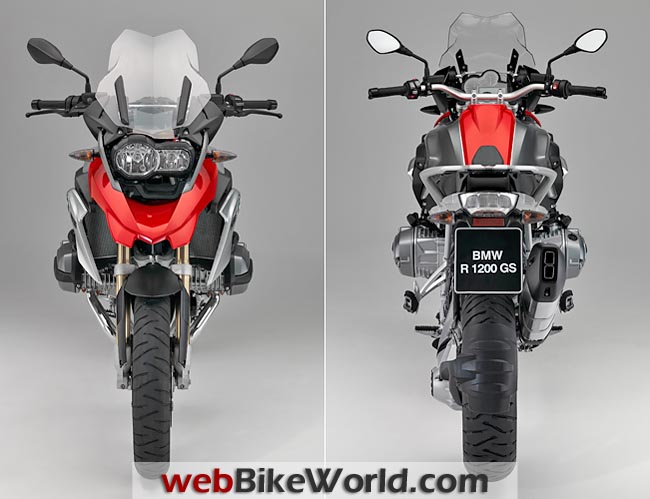
New Chassis
One of the primary goals in developing the new BMW R 1200 GS was to further increase the bike’s high level of riding dynamics while also creating a suspension which would extend the possible range of uses of the “big GS” both on and off the road.
The new, more rigid main frame including the steering-head bearing for the Telelever and the swingarm axle of the EVO Paralever has made it possible to significantly improve ride stability, handling and precision.
The bike also benefits from the improved suspension/damping set-up in terms of touring suitability, since lengthy trips are now more comfortable and less tiring for this reason.
While the frame of the R 1200 GS previously consisted of an upper frame to support and position the Telelever and the rear frame with integrated swingarm mount and welded on rear section, the chassis of the new R 1200 GS is now made of a continuous steel bridge frame with a bolt-on rear frame.
The latter offers particular benefits in terms of maintenance. However, the integration of the engine as a load-bearing element has been retained as this is beneficial to the bike’s weight and rigidity.
Semi-Active Suspension
With the optional Dynamic ESA, BMW Motorrad offers an electronic suspension which taps into a whole new range of possibilities as well as providing maximum riding safety and performance.
This semi-active suspension monitors the vertical movement of front and rear wheel control in travel and speed as well as other parameters by means of a spring travel sensor in each position and adapts the damping automatically to the situation depending on riding conditions and the maneuvers being carried out by the rider.
Dynamic ESA also responds to an ABS control brake maneuver, for example. Damping adjustment of the spring struts at front and rear is effected by means of electrically controlled regulation valves.
The drastically improved contact between road and tires means that the new R 1200 GS is able to provide a previously unequalled sense of security on very uneven roads and when riding off-road.
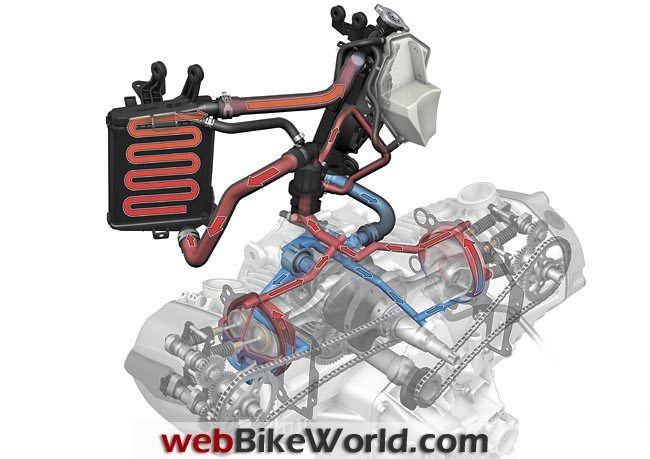


New Tire and Wheel Sizes
In order to provide a fuller ride feel and more harmonious response, in conjunction with increased directional accuracy and performance when braking and accelerating, the wheel and tire dimensions of the R 1200 GS were recalculated.
They were also defined over a number of highly involved development phases in collaboration with well-known tire manufacturers.
The tire dimension 120/70 R19 is used for the first time ever in a large enduro bike.
As compared to the previous tire size of 110/80-19, the tyres for the weight-optimized 10-spoke light alloy cast wheel enlarged to 3.0 inches (previously 2.5 inches) offer a larger contact area.
This has the effect of producing higher levels of transferrable cornering and deceleration forces.
But in practice, the rider benefits from more than just improved banking response and increased power transmission during braking. A special tire contour tailored to the new R 1200 GS also guarantees maximum neutrality when cornering as well as the very highest level of riding precision.
A newly defined tire is also used on the rear wheel of the R 1200 GS to enhance traction, cornering and ultimately riding dynamics, too.
While the R 1200 GS previously had a 150/70 R17 tire at the rear, a size 170/60 R17 tire now ensures a significantly larger contact surface for better cornering and traction.
In keeping with the new tire size, the rim width of the likewise weight-optimized 10-spoke light alloy rear wheel has also been increased from 4.0 to 4.5 inches.
And in the R 1200 GS, too, the extensive BMW Motorrad options program allows these to be fitted with cross-spoke wheels, especially for increased off-road use.
These have also been completely newly developed and are identical in size to the standard light alloy cast wheels
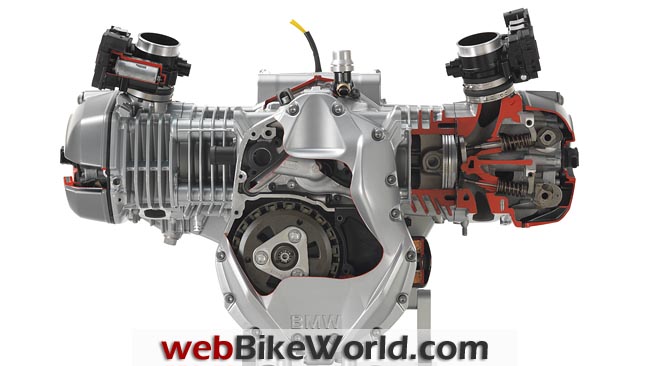


LED Headlight
Seeing and being seen as well as possible – these are crucial factors on which the safety and therefore fun of motorcycling depend. This is why BMW Motorrad also dedicated intense efforts to the development of a new lighting unit for the R 1200 GS.
The new standard halogen headlight is not only considerably smaller than the previous one. In terms of road illumination, too, it offers top-level lighting technology for both low and high beam.
Intensive tests in the BMW Group lighting tunnel have generated light levels which – given the same light emission area – achieve significantly better results in terms of perceptibility and vision for night riding as compared to the competition.
BMW Motorrad offers an additional daytime running light with LED technology as an ex works option. The unit consists of four LED modules and is integrated underneath the main halogen headlight.
The daytime running light allows other road users to differentiate the motorcycle much more clearly, thereby offering a huge safety benefit. What is more, the use of LED technology means a lower level of energy consumption and an extended lifetime.
The daytime running light is switched on either automatically via a light sensor or manually instead of the main headlight using the “Daytime running light” switch.
When darkness falls or when entering a tunnel, there is an automatic switchover to the halogen main headlight, providing optimum road illumination to ensure excellent visibility.
Optional Equipment Program
As usual, BMW has a huge number of options and accessories for the new 2013 R1200GS. See the attached .pdf for more information.
More Information
BMW has published a huge amount of information on the 2013 R1200GS; too much to publish here. The full press release is available in this .pdf .zip file. More information on pricing and availability will be published as it becomes available.
More wBW: 2014 BMW R1200GS Adventure | 2014 BMW Motorcycles
Owner Comments and Feedback
See details on submitting comments.
From “M.R.” (November 2012): “Thank you for the fine preliminary coverage of BMW’s new bike.
To put my comments in perspective let me briefly mention my background; I’ve been biking for over 4 decades (yea, I know, this really dates me), have owned dozens of bikes of all makes.
And I am blessed to currently own a Ducati Hypermotard, BMW R 1200 GSA, BMW X Challenge and KTM 950 SE.
I have loved motorcycling since I was a kid and not allowed to own one. Like many others I really enjoy exploring new country, both on and off road. I have around 600,000+ miles on two wheels.
I like BMW machines a lot and I think their dealers are the most professional out there, so this comes from a long time BMW fan.
I’ve ridden the GSA thru 3 foot water crossings, axle deep sand, baby head rock mountain passes, snow, a tornado, a flood, etc. I know how this machine works and what should be improved.
What limits this bike? Weight, gearing, complexity, balance, saddle from hell. Has BMW addressed any or all of these issues? I’m thinking not. Where does 125 PEAK horsepower come in useful?
Where the heck does peak power mean anything outside of marketing and the race track? These engines don’t suffer from heat induced failure at 100+ HP and they meet European and US air quality standards as is. So, why add complexity.
Is there more low end torque? Has the saddle from hell been changed?
Has the engine weight been lowered to improve off road balance? Is the overall machine simpler and easier to maintain? Can the gearing be changed easily and cheaply to accommodate different riding conditions?
Will this new bike make rock crawling speeds possible in difficult and dangerous conditions such as deep mud and off camber shelf roads? Has the pig been on a diet?
It would seem this new iteration of a good bike only makes it less usable, more of a toy than a tool, something for spoiled children to play with on carefully manicured safe riding courses. BMW management needs to grow a pair and lead rather than follow trends!”
From “D.L.” (October 2012): “The Ducati Panigale S has LED main and high beam headlights. How does BMW claim to be the first?”
Editor’s Reply: Good question, I’ll ask BMW.


